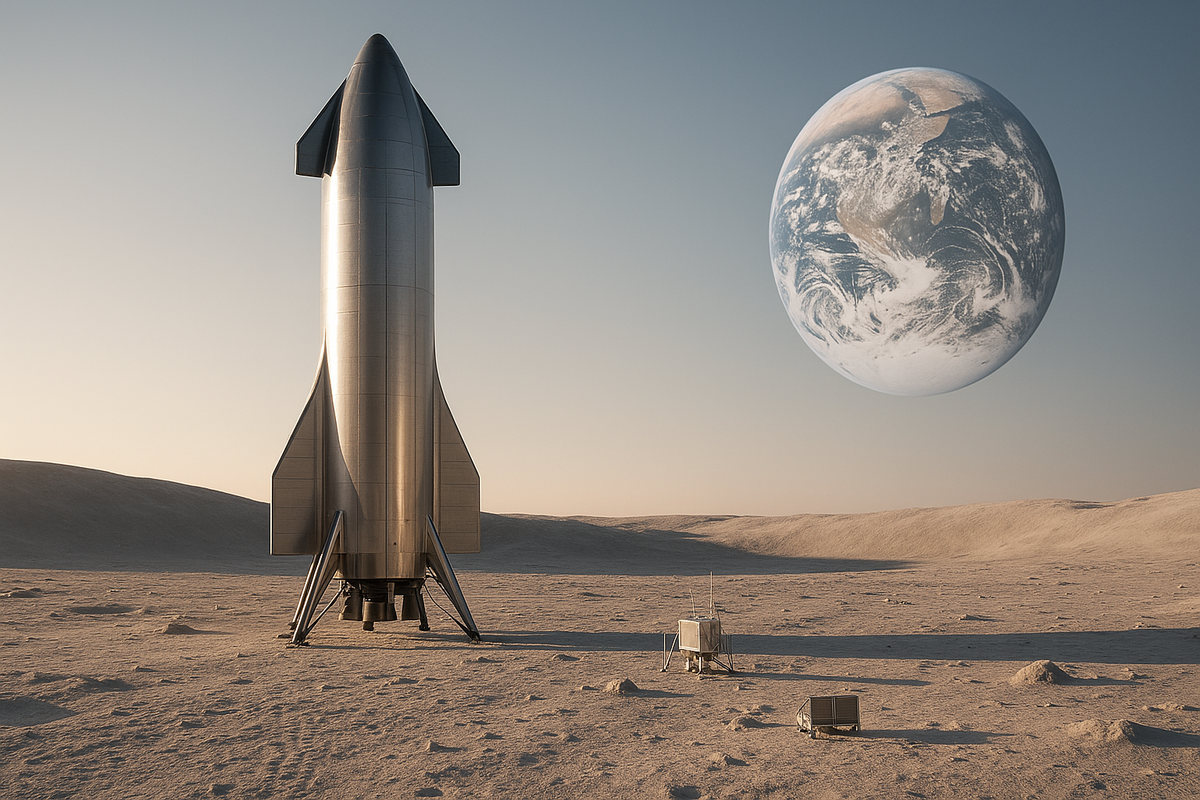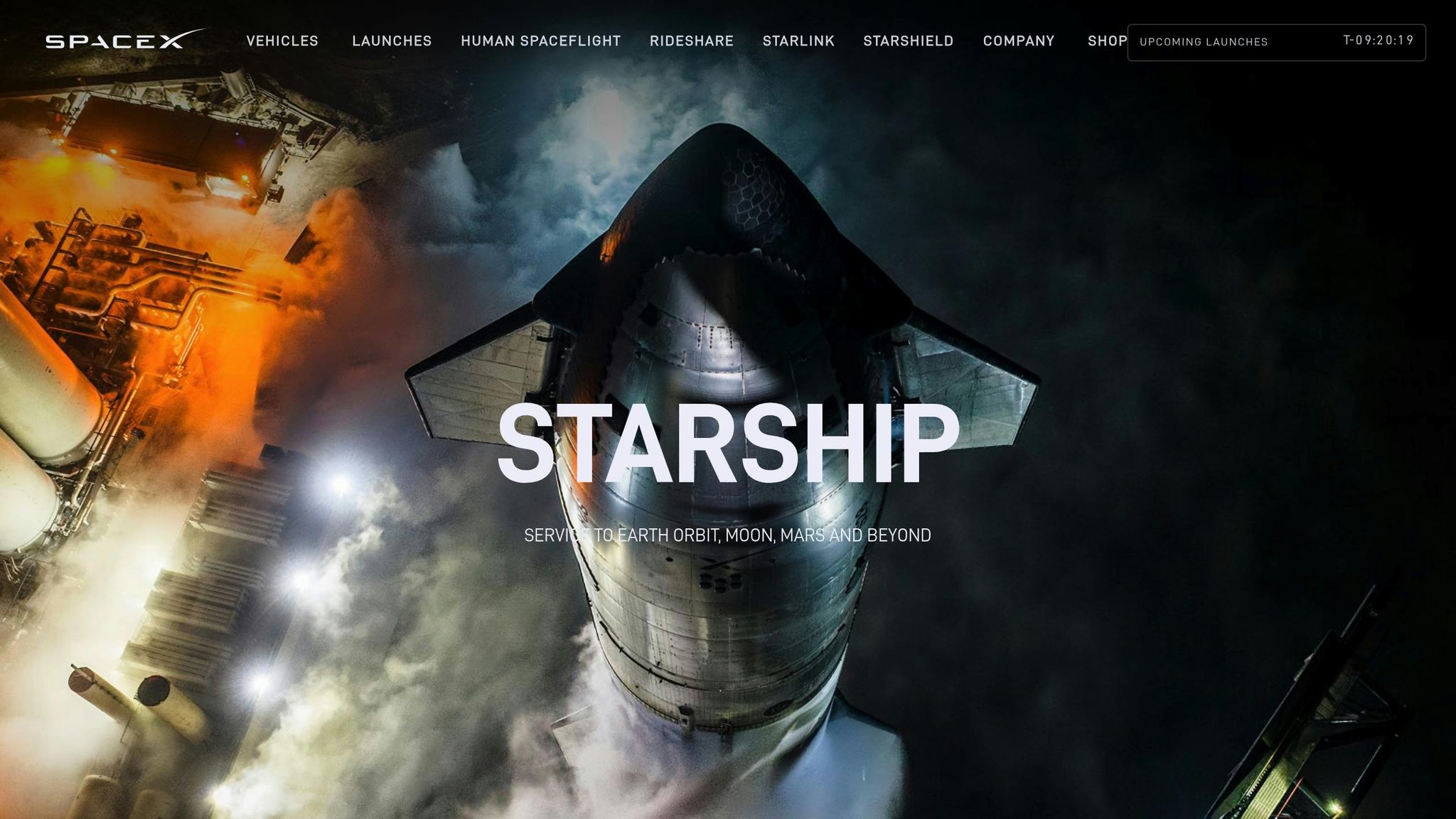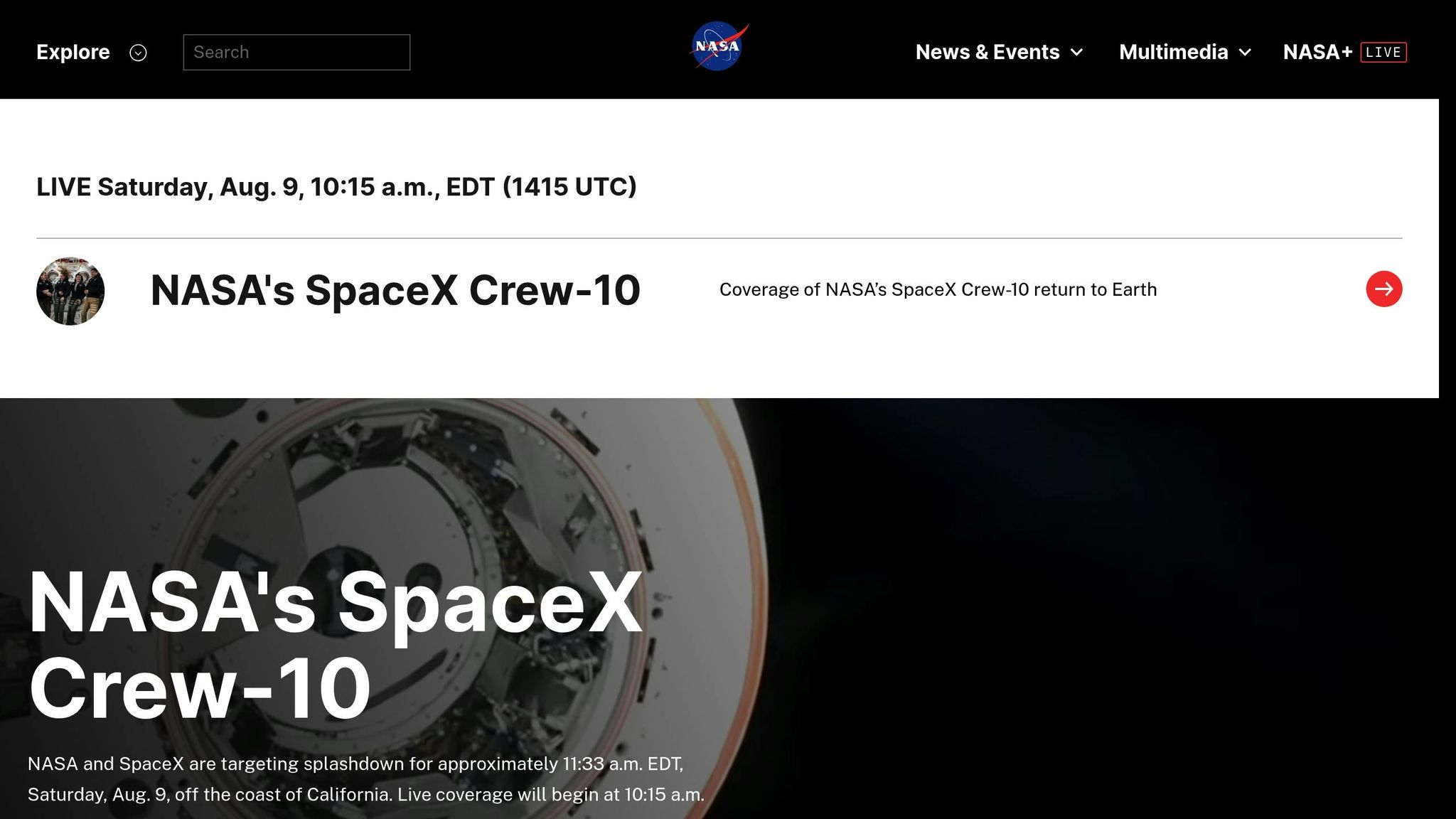How Starship Supports Artemis Moon Missions
Explore how a revolutionary spacecraft is set to redefine lunar exploration and support long-term missions on the Moon.

NASA’s Artemis program is reigniting lunar exploration with a focus on the Moon’s south pole, aiming to establish a long-term human presence. SpaceX’s Starship plays a key role as the Human Landing System (HLS), selected in 2021. Starship’s massive payload capacity and reusable design make it essential for delivering cargo, supporting crew activities, and laying the foundation for a lunar base.
Key Points:
- Artemis Timeline: Artemis I (2022, uncrewed), Artemis II (2025, crewed), Artemis III (2026, lunar landing).
- Starship Features: 165 ft tall, 100-ton payload, spacious interior for habitat and operations.
- Mission Process: Orion spacecraft docks with Starship in lunar orbit; Starship lands on the Moon and returns to orbit.
- Challenges: Orbital refueling, cryogenic fuel management, engine reliability, and meeting NASA safety standards.
While Starship offers unmatched capacity and reusability, its readiness depends on overcoming technical hurdles like orbital refueling and precision lunar landings. These advancements are critical for achieving the Artemis goals and expanding human space exploration.
How Starship Works in Artemis Missions

Starship Design for Lunar Landings
The Starship Human Landing System (HLS) takes a bold approach, stepping away from traditional lunar lander designs. It features a sturdy landing system and an interior tailored for extended surface missions. Early concepts reveal that the spacecraft will be customized for the Moon’s low gravity, with an interior designed to support crew activities and essential operational systems. This thoughtful design lays the groundwork for the mission stages described below.
Mission Steps with Starship HLS
The Artemis missions with Starship HLS follow a carefully planned sequence of events. After being refueled in low Earth orbit, Starship HLS will travel to lunar orbit, where it will rendezvous with the Orion spacecraft. Once the two vehicles have synchronized their operations, Starship will descend to the lunar surface to carry out mission activities. After completing its surface objectives, the lander will ascend back into lunar orbit to reunite with Orion, enabling the crew to return safely. These steps align seamlessly with the overall Artemis mission strategy.
Orbital Refueling and Cryogenic Propellant Transfer
A critical part of Starship’s lunar mission is its in-space refueling capability. Using liquid methane and oxygen as propellants, Starship HLS requires advanced thermal systems to manage cryogenic boil-off during automated propellant transfers in orbit. The process involves docking two spacecraft in orbit to transfer fuel, a complex procedure that relies on precise automation. SpaceX is actively working to overcome the challenges of minimizing propellant loss through improved thermal management. If successful, this technology will not only make lunar missions more efficient but could also pave the way for larger payloads to support the development of long-term lunar infrastructure.
Milestones and Challenges for Starship in Artemis
Required Milestones for Lunar Success
For SpaceX to achieve its goal of lunar exploration under Artemis, several critical milestones need to be reached. First, the company must demonstrate a safe, uncrewed lunar landing and ascent. This step involves showing that Starship can handle the Moon's challenging environment without direct human control. Precision landings on the Moon's surface and a successful return to orbit are essential to prove the spacecraft's capabilities.
Another crucial milestone is perfecting orbital refueling. SpaceX must show that cryogenic propellants can be reliably transferred between multiple Starship tankers. This process needs to be efficient and repeatable to ensure the lunar variant is fully prepared for its mission as the Human Landing System.
Additionally, NASA will require extensive testing of Starship's life-support systems. These systems must ensure the spacecraft can sustain astronauts for extended stays on the Moon, making long-term exploration possible.
While these steps provide a clear path forward, they also highlight the significant challenges SpaceX must overcome.
Development and Operations Challenges
Even with progress on these milestones, Starship faces several hurdles in development and operations. Engine reliability is at the top of the list. The Raptor engines must meet extremely high standards, as any failure during critical mission phases could endanger the crew.
Managing cryogenic propellants is another technical challenge. To minimize fuel losses during long operations, SpaceX must develop advanced thermal management systems, especially for orbital refueling.
Automated docking and precise guidance systems are equally critical. A small misalignment during orbital refueling could jeopardize the entire mission, emphasizing the need for flawless execution.
Finally, meeting NASA's rigorous safety standards adds layers of complexity. Extensive testing is required, covering everything from fault tolerance and emergency escape procedures to backup system validation. The landing systems also need to demonstrate exceptional precision to handle the Moon's uneven and unpredictable terrain safely. These requirements, while necessary, add time and complexity to Starship's development timeline.
Starship Benefits and Drawbacks for Artemis
Potential Advantages of Using Starship
The Starship program introduces a reusable spacecraft capable of handling various mission roles, including crew transport, cargo delivery, and serving as a temporary habitat for astronauts. These features, while promising, are still undergoing rigorous testing and validation to confirm their feasibility.
Challenges and Limitations
Starship's development has faced numerous technical obstacles, creating uncertainties about its readiness for Artemis missions. Setbacks such as test site explosions and multiple splashdown failures have raised questions about the spacecraft's reliability in its current form.
The complexity of the mission adds to these challenges. For instance, the Starship Human Landing System (HLS) must meet demanding requirements: docking with systems like the Gateway lunar station, landing in challenging terrains near the Moon’s South Pole, and functioning as a habitat for extended crew stays. Each of these objectives introduces additional layers of complexity that require thorough testing and validation.
Another critical aspect is the orbital refueling process. This method, which involves numerous tanker flights to fill Starship's fuel tanks in Earth orbit before heading to the Moon, remains unproven at the scale needed for Artemis missions. Persistent delays in development have also cast doubt on whether the Starship HLS will be ready in time for the Artemis III crewed mission, currently targeted for mid-2027. Furthermore, NASA mandates an uncrewed demonstration mission before any crewed flights can proceed, adding yet another hurdle to an already tight schedule.
Comparison Table: Pros and Cons
| Potential Advantages | Challenges |
|---|---|
| Reusable spacecraft design for multiple mission roles | Development delays, including test explosions and splashdown failures |
| Potentially efficient mission architecture | Orbital refueling process untested at required scale |
| Must meet stringent requirements for docking, lunar landings, and extended crew habitation | |
| Risk of missing the Artemis III mid-2027 target due to tight timelines |
Impact on SpaceX's Future and Investment Opportunities

Leadership in Space Exploration
NASA's decision to select Starship as its Human Landing System (HLS) signals a major step forward in space exploration. By combining the launch vehicle and spacecraft into a single reusable system, SpaceX is not only cutting costs but also reshaping how lunar missions are approached. This integrated approach highlights SpaceX's forward-thinking strategy and could pave the way for more government contracts in the future. Innovations like orbital refueling, initially developed for lunar missions, could also have broader commercial applications, further solidifying SpaceX's position as a leader in the field. These advancements aren't just about technology - they also lay a foundation for stronger financial performance.
Effects on SpaceX's Valuation
Securing this NASA contract boosts SpaceX's financial outlook in several ways. It reinforces the company's technical capabilities and provides a steady stream of revenue over the long term. This endorsement from NASA also strengthens confidence in SpaceX's business model, showcasing its ability to deliver cost-effective and reusable solutions for Artemis missions. These improvements not only sharpen SpaceX's competitive edge in government contracts but also make it a stronger player in the commercial space market. For private investors, these developments highlight the growing financial appeal of the company.
SpaceX Stock Investment Guide
For those looking to invest in SpaceX's growth, pre-IPO opportunities offer a chance to tap into its expanding market potential. Starship's critical role in the Artemis program underscores the company's innovative approach, which continues to attract investor interest. Since SpaceX remains privately held, traditional stock market options aren't available. However, resources like the SpaceX Stock Investment Guide provide valuable insights. This guide covers topics such as valuation analysis, funding updates, and factors influencing market value. It also explains private investment platforms like UpMarket, making it easier for individuals to explore opportunities in the private market.
Artemis III: NASA and SpaceX's Historic Moon Landing Mission | WION Podcast

Conclusion: Starship's Role in Shaping Lunar Exploration
Starship is set to transform lunar exploration as NASA's chosen Human Landing System (HLS) for the Artemis program. Its reusable design and ability to refuel in orbit open the door to more daring and far-reaching space missions. NASA's selection underscores the spacecraft's groundbreaking design and potential. These advancements are poised to reshape how missions are planned and executed, pushing the boundaries of human space exploration.
FAQs
What makes SpaceX's Starship unique compared to traditional lunar landers?
SpaceX's Starship breaks the mold when compared to traditional lunar landers, thanks to its impressive size, reusability, and multi-purpose design. While conventional landers are often smaller and designed for single-use, Starship is built to be fully reusable and can transport over 100 metric tons of cargo or multiple astronauts to the lunar surface in just one mission.
Its cutting-edge design enables autonomous operations and supports a variety of mission profiles. Whether it’s hauling heavy equipment, conducting scientific experiments, or aiding extended lunar exploration, Starship is built to handle it all. This combination of flexibility and capacity puts it in a league of its own, far beyond the limitations of traditional landers.
What challenges is SpaceX addressing to make Starship ready for NASA's Artemis Moon missions?
SpaceX is tackling several technical hurdles as it gears up Starship for NASA's Artemis program. Among these challenges are increasing payload capacity to align with mission demands, creating dependable in-space refueling systems for lunar operations, and resolving problems such as tank failures encountered during testing. Another crucial step involves completing uncrewed lunar demonstration landings before the spacecraft can carry astronauts.
To address these obstacles, SpaceX is reworking critical elements like fuel tanks, pushing forward with refueling technology, and conducting thorough testing to pinpoint and fix potential issues. These steps are key to ensuring Starship is prepared for safe and effective lunar missions.
Why is orbital refueling so important for Starship in NASA's Artemis program, and what breakthroughs are needed to make it work?
Orbital refueling is set to transform Starship's role in NASA's Artemis program. By enabling the spacecraft to refuel while in orbit, this technology extends its range, making it capable of tackling critical lunar missions. That means Starship can play a key part in landing astronauts on the Moon and laying the groundwork for future deep-space exploration.
Achieving this, however, requires overcoming some technical challenges. Engineers need to create dependable in-space refueling systems, design tanker spacecraft specifically for these missions, and master the management of cryogenic fluids like liquid oxygen and methane in zero-gravity conditions. These advancements will not only make Starship a reliable asset for Artemis missions but also open up possibilities for human exploration of Mars and beyond.
Comments ()